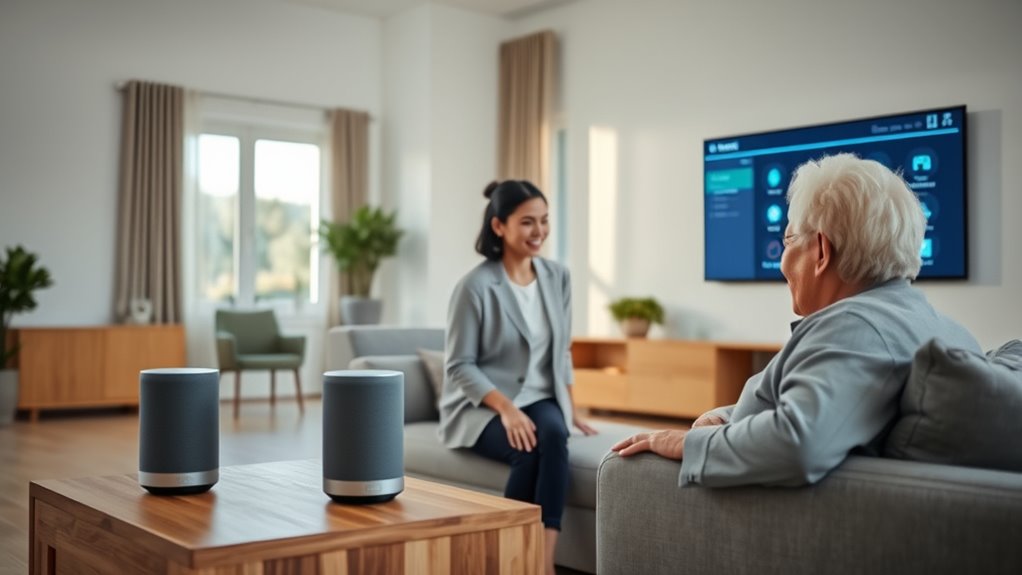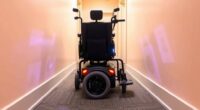Voice‑first homes use intuitive voice control technology to help you manage household devices easily and independently, even with mobility challenges. You can control lights, thermostats, security systems, and appliances using simple speech commands. This technology reduces physical effort, enhances safety, and boosts confidence in everyday tasks. As these systems learn your preferences, they become more personalized over time. If you’re curious about how these homes can transform your daily life, there’s much more to discover ahead.
Key Takeaways
- Voice control enables hands-free management of lights, thermostats, and appliances, reducing physical effort for users with mobility challenges.
- Natural language understanding allows users to operate home systems easily without learning complex commands.
- Voice-first homes enhance safety by providing remote security system access and camera viewing through simple voice commands.
- Integration with assistive devices and customizable features supports personalized accessibility and independence.
- Ongoing advancements in voice technology help homes adapt to user needs, improving overall safety and daily convenience.

Imagine a home where your voice is all it takes to control lights, thermostats, security systems, and even appliances. For people with mobility challenges, this kind of environment offers a new level of independence and convenience. You no longer have to struggle with switches, remotes, or smartphones to access essential functions around your house. Instead, you simply speak your commands, and your smart home responds instantly. This seamless interaction can dramatically reduce the physical effort needed to perform everyday tasks, making your home more accessible and comfortable.
Voice-first technology is designed to understand natural language, so you don’t need to learn specific commands or worry about complex menus. You can say, “Turn on the living room lights,” or “Set the thermostat to 72 degrees,” and the system will execute your request. If you have difficulty moving, this means you can avoid reaching for switches or fumbling with small controls. The ease of voice control helps you stay independent, giving you confidence that your home is responsive to your needs. It also minimizes the risk of accidents caused by trying to reach or operate devices manually.
Voice technology understands natural language, making home control simple and accessible for everyone.
In addition to controlling lights and temperature, voice technology enables you to manage security features effortlessly. You can check if doors are locked, arm or disarm the alarm system, or even view security camera footage using simple spoken commands. This reduces the need to physically access security panels or mobile apps, which might be challenging if you have limited mobility. You can also operate appliances like coffee makers, ovens, or robotic vacuums, making daily routines smoother and less physically demanding.
Furthermore, voice-first homes can be integrated with other assistive devices, creating a detailed support system tailored to your needs. For example, if you use mobility aids or have hearing impairments, voice commands can be supplemented with visual cues or notifications. Some systems offer multi-language support and customizable responses, ensuring they’re accessible to a wide range of users. With ongoing advancements, these homes are becoming smarter and more intuitive, learning your preferences over time to anticipate your needs. Additionally, incorporating expert advice can help ensure the technology is tailored to maximize accessibility and safety for your specific situation.
Frequently Asked Questions
How Secure Are Voice-Activated Home Systems Against Hacking?
Voice-activated home systems can be secure if you use strong, unique passwords and enable multi-factor authentication. Keep your software updated to patch vulnerabilities. Be cautious about voice commands in public or shared spaces, as unauthorized users might try to access your system. Regularly review security settings and avoid sharing voice access codes. While no system is entirely foolproof, proactive measures greatly reduce the risk of hacking.
Can Voice-First Technology Integrate With Existing Smart Home Devices?
Yes, voice-first technology can seamlessly integrate with your existing smart home devices. You just need compatible systems and a few setup steps, like linking your devices through a central app or platform. Once connected, you can control lights, thermostats, security cameras, and more with simple voice commands. This integration makes managing your home more convenient, allowing you to control everything effortlessly and improve your overall living experience.
What Is the Cost of Implementing Voice-First Solutions for Homes?
Implementing voice-first solutions in your home can cost between $50 and $300 per device, depending on features and brand. If you choose an all-encompassing system with multiple devices and advanced capabilities, expenses can reach $1,000 or more. Keep in mind, installation costs may vary if you hire professionals. Overall, consider your budget and needs to find a solution that offers the best value and functionality for your home.
How User-Friendly Are Voice Commands for Elderly or Disabled Users?
You might think voice commands are a breeze for elderly or disabled users, but sometimes they’re more like a puzzle. Still, most systems are designed with simplicity in mind, featuring clear prompts and customizable options. With a bit of practice, you’ll find voice controls become intuitive, making daily tasks easier. Ironically, what seems complex at first often turns into your most helpful assistant, seamlessly adapting to your needs.
What Are Privacy Concerns Related to Voice Data Collection?
You should be aware that voice data collection raises privacy concerns because your conversations might be recorded, stored, or shared without your explicit consent. There’s a risk of sensitive information being accessed or misused. To safeguard yourself, regularly review privacy settings, understand how your data is used, and choose devices with transparent data policies. Staying informed helps ensure your voice data remains secure and your privacy is respected.
Conclusion
Voice-first homes are like a trusted companion, always ready to assist and adapt to your needs. They empower you to navigate daily tasks effortlessly, turning challenges into opportunities for independence. Just as a lighthouse guides ships safely to shore, these homes illuminate your path to a more accessible, comfortable life. Embrace this technology, and you’ll find that your home becomes a true partner—supporting you with the patience and understanding of a good friend.









